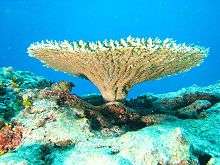Coral Triangle
The Coral Triangle is a roughly triangular area of the tropical marine waters of Indonesia, Malaysia, Papua New Guinea, Philippines, Solomon Islands and Timor-Leste that contain at least 500 species of reef-building corals in each ecoregion.[1] This region encompasses portions of two biogeographic regions: the Indonesian-Philippines Region, and the Far Southwestern Pacific Region.[2] The Coral Triangle is recognized as the global centre of marine biodiversity[3] and a global priority for conservation.[4] It is also called the "Amazon of the seas" and covers 5.7 million square kilometres (2,200,000 sq mi) of ocean waters.[5] Its biological resources sustain the lives of over 120 million people.[6] According to the Coral Triangle Knowledge Network, about $3 billion in fisheries exports and another $3 billion in coastal tourism revenues are derived as annual foreign exchange income in the region.
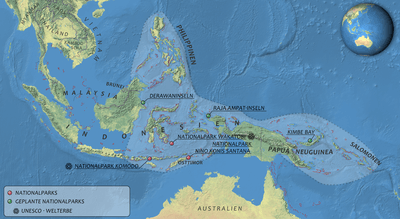
The WWF considers the region a top priority for marine conservation, and the organization is addressing the threats it faces through its Coral Triangle Program,[7] launched in 2007. The center of biodiversity in the Triangle is the Verde Island Passage in the Philippines,[8] while the only coral reef site declared as a UNESCO World Heritage Site in the region is the Tubbataha Reef Natural Park, also in the Philippines.[9]
Biodiversity
While only covering 1.6% of the planet’s oceanic area, the region has 76% of all known coral species in the world. As a habitat for 52% of Indo-Pacific reef fishes and 37% of the world's reef fishes, it encompasses the highest diversity of coral reef fishes in the world[10] More than 3,000 species of fish live in the Coral Triangle, including the largest fish - the whale shark, and the coelacanth. The Coral Triangle is the epicentre for the biodiversity of not only corals and fish, but many other marine organisms as well. It also provides habitat to six out of the world's seven marine turtle species.
The Coral Triangle also has the greatest extent of mangrove forests in the world. The large area and extraordinary range of habitats and environmental conditions have played a major role in maintaining the staggering biodiversity of the Coral Triangle.[11]
.jpg) Table coral Acropora latistella
Table coral Acropora latistella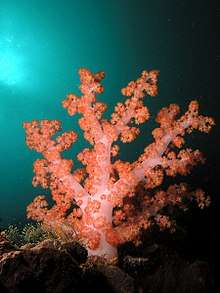 Pink soft coral
Pink soft coral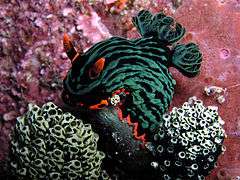
 Christmas tree worms (Spirobranchus giganteus)
Christmas tree worms (Spirobranchus giganteus)
.jpg)
 Anemonefish (Amphiprion ocellaris)
Anemonefish (Amphiprion ocellaris)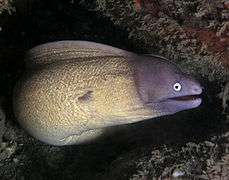 White-eyed moray eel (Gymnothorax thyrsoideus)
White-eyed moray eel (Gymnothorax thyrsoideus)
Threats
The Coral Triangle sits at a crossroads of rapidly expanding populations, economic growth and international trade.[12] The biodiversity and natural productivity of the Coral Triangle are under threat from poor marine management (primarily from the coastal development, and overfishing and destructive fishing), lack of political will, poverty, a high market demand and local disregard for rare and threatened species, and climate change (warming, acidifying and rising seas). Coral reefs have experienced mass bleaching, which threaten to degrade the important ecosystems. An estimated 120 million people live within the Coral Triangle, of which approximately 2.25 million are fishers who depend on healthy seas to make a living. These threats are putting at risk livelihoods, economies and future market supplies for species such as tuna.[13] Studies have highlighted the alarming decline of coral cover in this region.[14]
Since the marine resources are a principal source of income for the population, the downstream effects of losing these critical coastal ecosystems are enormous.
Conservation
The Coral Triangle is the subject of high-level conservation efforts by the region's governments, nature conservation organizations such as World Wide Fund for Nature, The Nature Conservancy and Conservation International, and donor agencies such as the Asian Development Bank, the Global Environment Facility and USAID.
Coral Triangle Initiative on Coral Reefs, Fisheries, and Food Security
On August 2007, Indonesia's President Yudhoyono proposed a multilateral partnership to "safeguard the region’s marine and coastal biological resources" with five other countries geographically located in the Coral Triangle (Malaysia, Timor-Leste, Papua New Guinea, Solomon Islands, and the Philippines).[12] The multilateral partnership then named as Coral Triangle Initiative on Coral Reefs, Fisheries and Food Security (CTI-CFF).
Goals of CTI-CFF[12]
- Priority seascapes designated and effectively managed
- Ecosystem Approach to Management of Fisheries (EAFM) and other marine resources fully applied
- Marine Protected Areas (MPAs) established and effectively managed
- Climate change adaptation measures achieved
- Threatened species status improving
Delineation
The primary criteria used to delineate the Coral Triangle were:
- High species biodiversity (more than 500 coral species, high biodiversity of reef fishes, foraminifera, fungid corals, and stomatopods) and habitat diversity
- Oceanography (currents)
There is considerable overlap between the boundaries of the Coral Triangle that are based primarily on high coral biodiversity (more than 500 species), and the boundaries based on the area of greatest biodiversity for coral reef fishes.[15][16]
Media
The 2013 documentary film Journey to the South Pacific tells the story of Coral Triangle conservation against the backdrop of island life.[17]
See also
- Coral Triangle Initiative on Coral Reefs, Fisheries, and Food Security
- Coral Triangle Day
- List of reefs
- Great Barrier Reef – The largest coral reef on Earth, the northern portion of which lies within the Coral Triangle
References
- Veron et al. Unpublished data
- Veron, J.E.N. 1995. Corals in space and time: biogeography and evolution of the Scleractinia. UNSW Press, Sydney, Australia: xiii + 321 pp.
- Allen, G. R. 2007 Conservation hotspots of biodiversity and endemism for Indo-Pacific coral reef fishes. Aquatic Conserv: Mar. Freshw. Ecosyst. doi:10.1002/aqc.880
- Briggs, J. C. 2005a. The marine East Indies: diversity and speciation. Journal of Biogeography 32: 1517-1522
- "ADB to help improve resources management in coral triangle". Archived from the original on 2018-03-17. Retrieved 2011-05-23.
- "Coral reef destruction spells humanitarian disaster".
- WWF Coral Triangle Program
- "Verde Island Passage".
- ""World Heritage Coral Reefs" Exhibit opens in Paris".
- Hoegh-Guldberg, O (2009). The Coral Triangle and Climate Change: Ecosystems, People, and Societies at Risk (PDF). Sydney: WWF Australia. ISBN 978-1-921031-35-9. Archived from the original (PDF) on 2017-01-17. Retrieved 2016-03-30.
- The Nature Conservancy. Coral Triangle Facts, Figures, and Calculations: Part II: Patterns of Biodiversity and Endemism, December 16, 2008
- "CTI Regional Plan of Action | CTI-CFF". www.coraltriangleinitiative.org. Retrieved 2016-03-30.
- http://www.panda.org/what_we_do/where_we_work/coraltriangle/problems/ WWF - Problems in the Coral Triangle
- Peñaflor et al. 2009. Sea-surface temperature and thermal stress in the Coral Triangle over the past two decades. Coral Reefs 28:4. pp 841-850
- The Nature Conservancy. 2004. Delineating the Coral Triangle, its ecoregions and functional seascapes. Report on an expert workshop, held at the Southeast Asia Center for Marine Protected Areas, Bali, Indonesia, (April 30 - May 2, 2003), Version 1.1 (June 2004)
- Hoeksema BW. 2007.Delineation of the Indo-Malayan Centre of Maximum Marine Biodiversity: The Coral Triangle. In: W. Renema (ed.) Biogeography, Time and Place: Distributions, Barriers and Islands, pp 117-178. Springer, Dordrecht.
- Chang, Justin (December 13, 2013). "Film Review: 'Journey to the South Pacific'". Variety. Retrieved 10 February 2014.
External links
- Coral Triangle Knowledge Network
- Coral Triangle Initiative, main site
- Coral Triangle Photo Expedition Blog
- The Nature Conservancy - Coral Triangle Center
- WWF Coral Triangle Programme - international website
- WWF Coral Triangle Programme - US website
- The biodiversity in the coral triangle of Indonesia | Why could develop so many species in Indonesia? (engl.)
